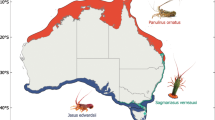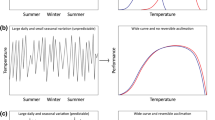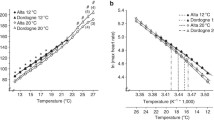Abstract
The American lobster is a poikilotherm that inhabits a marine environment where temperature varies over a 25°C range and depends on the winds, the tides and the seasons. To determine how cardiac performance depends on the water temperature to which the lobsters are acclimated we measured lobster heart rates in vivo. The upper limit for cardiac function in lobsters acclimated to 20°C is approximately 29°C, 5°C warmer than that measured in lobsters acclimated to 4°C. Warm acclimation also slows the lobster heart rate within the temperature range from 4 to 12°C. Both effects are apparent after relatively short periods of warm acclimation (3–14 days). However, warm acclimation impairs cardiac function at cold temperatures: following several hours exposure to frigid (<5°C) temperatures heart rates become slow and arrhythmic in warm acclimated, but not cold acclimated, lobsters. Thus, acclimation temperature determines the thermal limits for cardiac function at both extremes of the 25°C temperature range lobsters inhabit in the wild. These observations suggest that regulation of cardiac thermal tolerance by the prevailing environmental temperature protects against the possibility of cardiac failure due to thermal stress.




Similar content being viewed by others
Abbreviations
- C:
-
Celsius
- ABT:
-
Arrhenius break temperature
- CTmax :
-
Critical thermal maximum
- Hz:
-
Hertz
- K:
-
Kelvin
References
Commission ASMF (2005) Species profile: American lobster. Peer-reviewed stock assessment presents new opportunities and challenges for lobster management. ASMFC Fish Focus 14:4–6
Cowan DF, Watson W, Solow A, Mountcastle A (2006) Thermal histories of brooding lobsters, Homarus americanus, in the Gulf of Maine. Mar Biol (published online 14 June 2006)
Crowder M, Hand D (1990) Analysis of repeated measures. Chapman & Hall, London
Cuculescu M, Pearson T, Hyde D, Bowler K (1999) Heterothermal acclimation: an experimental paradigm for studying the control of thermal acclimation in crabs. Proc Natl Acad Sci USA 96:6501–6505
Cuomo C, Valente R, Dogru D (2005) Seasonal variations in sediment and bottom water chemistry of Western Long Island Sound: implications for lobster mortality. J Shellfish Res 24:805–814
Draxler AFJ, Robohm RA, Wieczoerk D, Kapareiko D, Pitchford S (2005) Effect of habitat biogeochemicals on survival of lobsters (Homarus Americanus). J Shellfish Res 24:821–824
Glenn RP, Pugh T (2005) Observations on the chronology and distribution of lobster shell disease in Massachusetts coastal waters. In: Thusty M, Halvorson H, Smolowitz R, Sharma U (eds) State of lobster science: lobster shell disease workshop. Aquatic Forum Series Final Report 05–1., Aquatic Forum Series Final Report 05-1 edn. New England Aquarium, Boston, pp 141–155
Green E, Carrit D (1967) New tables of oxygen saturation of seawater. J Mar Res 25:140–147
Howell P, Benway J, Giannini C, McKown K, Burgess R, Hayden J (2005) Long-term population trends in American lobster (Homarus americanus) and their relation to temperature in Long Island Sound. J Shellfish Res 24:849–857
Jacobs JR, Atwood HL (1981) Effects of thermal history on long term neuromuscular faciliation in intact crayfish and isolated claw preparations. J Comp Physiol 143:53–60
Jury SH, Watson WH (2000) Thermosensitivity of the lobster, Homarus americanus, as determined by cardiac assay. Biol Bull 199:257–264
Lawton P, Lavalli K (1995) Postlarval, juvenile, adolescent, and adult ecology. In: Factor JR (ed) Biology of the lobster Homarus Americanus. Academic, San Diego, pp 47–88
Manning J (2005) Environmental monitors on lobster traps (eMOLT). In: http://www.sole.wh.whoi.edu/∼jmanning/emolt.html
McLeese DW (1956) Effects of temperature, salinity, and oxygen on the survival of the American lobster. Can J Fish Res Board Can 13:247–272
Pearce J, Balcom N (2005) The 1999 Long Island Sound lobster mortality event: findings of the comprehensive research initiative. J Shellfish Res 24:691–697
Pearson T, Hyde D, Bowler K (1999) Heterologous acclimation: a novel approach to the study of thermal acclimation in the crab Cancer pagarus. Am J Physiol 277:R24–R30
Somero GN (2005a) Evolutionary and acclimation-induced variation in the thermal limits of heart function in congeneric marine snails (Genus Tegula): implications for vertical zonation. Biol Bull 208:138–144
Somero GN (2005b) Linking biogeography to physiology: evolutionary and acclimatory adjustments of thermal limits. Front Zool 2:1
Spees JL, Chang SA, Snyder MJ, Chang ES (2002) Thermal acclimation and stress in the American lobster, Homarus americanus: equivalent temperature shifts elicit unique gene expression patterns for molecular chaperones and polyubiquitin. Cell Stress Chaperones 7:97–106
Stenseng E, Braby CE, Somero GN (2005) Evolutionary and acclimation-induced variation in the thermal limits of heart function in congeneric marine snails (Genus Tegula): implications for vertical zonation. Biol Bull 208:138–144
Stillman JH (2003) Acclimation capacity underlies susceptibility to climate change. Science 301:65
Stillman JH, Somero GN (2000) A comparative analysis of the upper thermal tolerance limits of eastern Pacific porcelain crabs, genus Petrolistehs: influences of latitdue, vertical zonation, acclimation and phylogeny. Physiol Biochem Zool 73:200–208
Worden M, Clark C, Conaway M, Qadri S (2006) Temperature dependence of cardiac performance in the lobster Homarus americanus. J Exp Biol 209:1024–1034
Acknowledgments
The authors are grateful to Jasmit Brar for experimental assistance, and Brian Duling and Deforest Mellon for helpful discussions. The experiments described here comply with the “Principles of animal care”, publication No. 86–23, revised 1985 of the National Institutes of Health, and also with the current laws of the United States of America.
Author information
Authors and Affiliations
Corresponding author
Rights and permissions
About this article
Cite this article
Camacho, J., Qadri, S.A., Wang, H. et al. Temperature acclimation alters cardiac performance in the lobster Homarus americanus . J Comp Physiol A 192, 1327–1334 (2006). https://doi.org/10.1007/s00359-006-0162-1
Received:
Revised:
Accepted:
Published:
Issue Date:
DOI: https://doi.org/10.1007/s00359-006-0162-1




